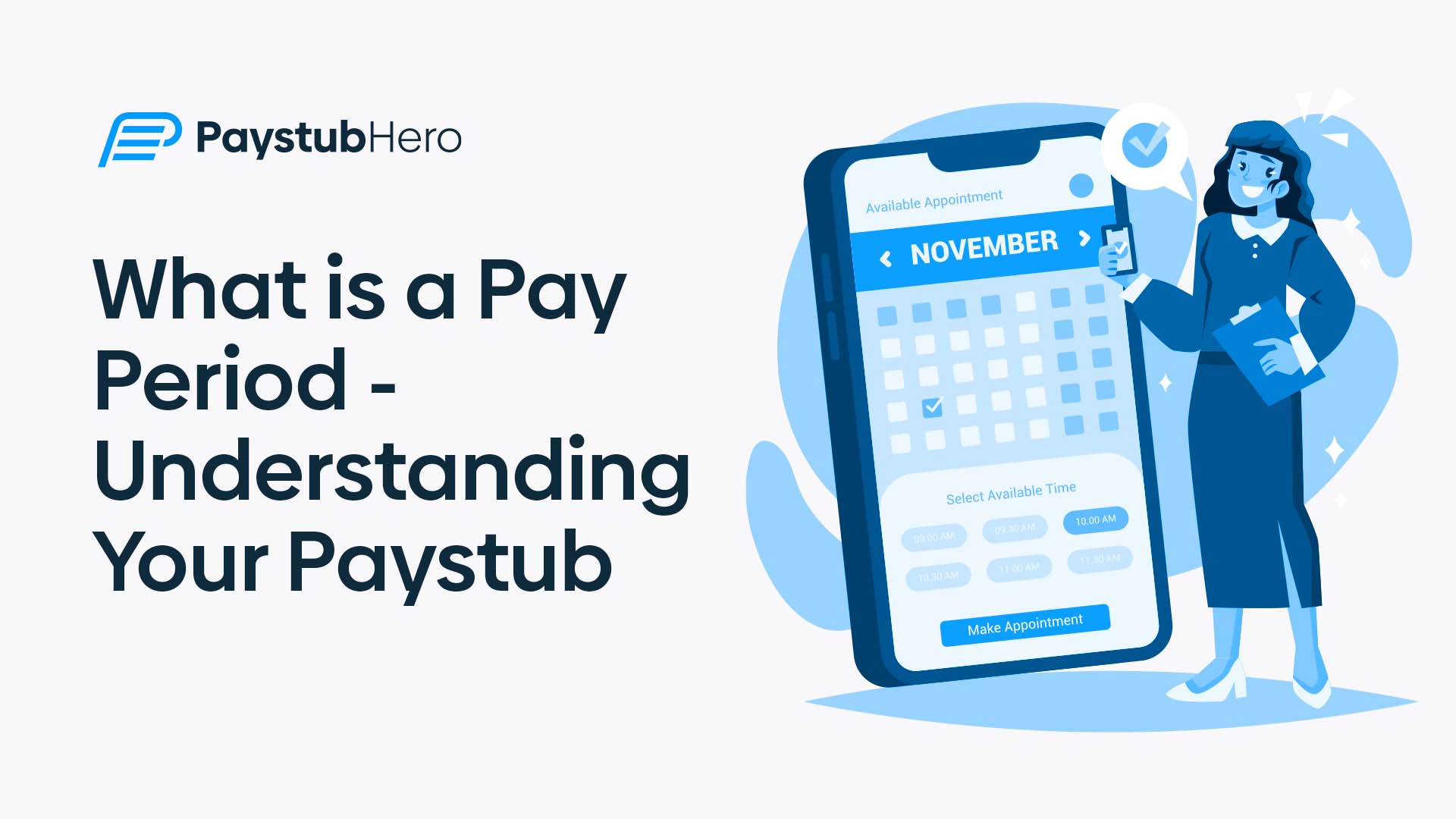You’ve just landed your first job or perhaps you’ve switched to a new company. You’re thrilled to receive your first paycheck, and when you do, you find a series of numbers, terms, and dates on your paystub that you might not completely understand.
In the simplest terms, a pay period is the recurring length of time over which employee time is recorded for payroll. Understanding this concept is crucial because it determines when you’ll receive your paycheck and how much it will be.
Your pay period affects not only your financial planning and budgeting but also has potential implications for your tax situation and overtime eligibility.
Pay periods and paystubs may seem complex, especially for those who are new to the workforce or those who have switched from being paid as an independent contractor to a full-time employee.
They include numerous details such as gross pay, net pay, tax withholdings, and benefits deductions. All these elements come together to present the full picture of your income and deductions.
To help you navigate this seemingly complex landscape, we’ve compiled a comprehensive guide that will simplify the concept of a pay period and how it appears on your paystub.
Table of Contents
- Introduction
- Unraveling the Mystery: What is a Pay Period?
- Dissecting Pay Period Types: Understanding Biweekly and Semi-Monthly Pay Schedules
- Unraveling the Mystery: Decoding the Key Aspects of Your Paystub
- The Art of Counting: Frequency Matters – How Many Paychecks in a Year?
- Pay Schedule Spotlight: The Relevance of Biweekly Pay
- Practical Pathways: Actionable Steps to Understanding Your Paystub
- Your Trusted Ally: Your Payroll Solution with PaystubHero
- Conclusion
Dissecting Pay Period Types: Understanding Biweekly and Semi-Monthly Pay Schedules
One common area of confusion, when people start a new job or review their paystubs, often centers around understanding the type of pay period they’re on, especially when it’s a biweekly or semi-monthly pay period.
The type of pay period plays a crucial role in determining how often you get paid and how much each paycheck will be, influencing your personal finance and budgeting.
So, what is a biweekly pay period? It is a pay schedule where employees receive their paychecks every other week, typically on a specific day such as Friday. This results in 26 paychecks in a year.
Many employees prefer this type of pay schedule because the extra two paychecks a year (compared to semi-monthly) can feel like a bonus and help with additional expenses or savings goals.
On the flip side, the semi-monthly meaning refers to a pay schedule where you receive your paycheck twice a month, typically on fixed dates such as the 1st and 15th, or the 15th and last day of the month. Unlike biweekly pay periods, the semi-monthly pay schedule leads to 24 pay periods in a year, regardless of how many weeks are in a particular month.
This setup could be beneficial for those who prefer a more predictable pay schedule, especially when it comes to planning regular expenses like mortgage payments or utility bills that usually occur monthly.
Both biweekly and semi-monthly pay periods have their advantages and it’s essential to understand which one applies to you to manage your finances effectively.
Unraveling the Mystery: Decoding the Key Aspects of Your Paystub
Your paystub is more than just a piece of paper or a digital record showing how much you’ve been paid. It’s a detailed statement that breaks down your income and deductions for a specific pay period, providing you with a clear picture of where your money comes from and where it’s going.
It’s an essential document that you might need for everything from applying for a loan to filing your taxes. Therefore, understanding it thoroughly is critical.
When examining your paystub, there are three main sections to consider:
Gross Pay: This is the total amount you earned in a pay period before any deductions are taken out. If you’re a salaried employee, it’s your annual salary divided by the number of pay periods in a year.
For hourly employees, it’s the number of hours worked times the hourly rate. Your gross pay may also include other types of compensation, such as overtime, bonuses, or commissions.
Deductions: These are amounts taken out of your gross pay. They include various items such as tax withholdings (federal, state, and local), social security, Medicare, insurance costs (health, dental, life, etc.), and contributions to retirement plans. Depending on your employer, there might be other deductions like union dues or charitable donations.
Net Pay: This is the amount you actually receive in your bank account, also known as your “take-home” pay. It’s your gross pay minus all the deductions.
By understanding these key aspects, you can make sure that your pay is calculated correctly, plan your budget effectively, and ensure that the right amounts are being put towards taxes and other important contributions.
The Art of Counting: Frequency Matters – How Many Paychecks in a Year?
An often overlooked, yet critical aspect of understanding your income and planning your finances revolves around the question: how many paychecks in a year will I receive?
The answer to this question will determine how often you receive an influx of income and help you create an effective budget plan.
While you might think that this number would be relatively standard, the reality is that it can vary significantly based on the pay schedule your employer follows.
Different businesses choose different pay schedules depending on various factors like their size, industry, and state laws. Therefore, it’s essential to understand the frequency of your pay.
Let’s break it down according to common pay schedules:
Biweekly: If your employer uses a biweekly pay schedule, you’ll get 26 paychecks in a year. This is because there are approximately 52 weeks in a year, and if you’re getting paid every two weeks (which is half of a month), you’ll receive 26 paychecks.
Semi-monthly: If they follow a semi-monthly pay schedule, you’ll receive 24 paychecks. This is because semi-monthly means that you’re paid twice a month, and since there are 12 months in a year, you’ll get 24 paychecks.
Weekly: Some employers, especially those with hourly workers, might use a weekly pay schedule, resulting in 52 paychecks in a year.
Monthly: Less common but still used in some cases, particularly for high-level positions or contractors, a monthly pay schedule will result in 12 paychecks in a year.
By understanding the frequency of your pay, you can better anticipate your income and plan your finances accordingly. Remember, it’s not just about how much you earn, but also about when and how often that money arrives in your bank account.
Pay Schedule Spotlight: The Relevance of Biweekly Pay
Having delved into various types of pay schedules and their frequencies, we now cast a spotlight on one of the most common pay periods – the biweekly pay. Many businesses, big and small, utilize biweekly pay periods, making it a relevant topic for a broad spectrum of employees. But what is biweekly pay, and why is it significant?
Biweekly pay, as the name suggests, is when you’re paid every two weeks. This typically translates to 80 hours of pay for full-time employees, though this can vary for those with fluctuating work hours.
The reason why this pay schedule is widely used and liked is because it offers a balance between payroll processing costs for the employer and the predictability of income for the employee.
For businesses, running payroll biweekly instead of weekly can save time and reduce costs associated with payroll processing. For employees, receiving a paycheck every two weeks can make budgeting easier compared to a monthly pay schedule, while also offering a financial boost compared to semi-monthly schedules.
You see, while at first glance, biweekly and semi-monthly pay periods might seem almost identical, they’re not. Over the course of a year, a biweekly pay schedule results in 26 paychecks (since a year is approximately 52 weeks long), whereas a semi-monthly pay schedule results in only 24 paychecks.
That’s essentially an extra month’s pay for those on a biweekly schedule, which can feel like a bonus and contribute significantly to savings or managing larger expenses.
As an employee, understanding your pay frequency and being able to navigate the landscape of your income is crucial. It aids you in managing your financial expectations and planning for both short-term needs and long-term goals.
Practical Pathways: Actionable Steps to Understanding Your Paystub
To the uninitiated, a paystub can seem like a confusing jumble of numbers, acronyms, and legal terms. However, once you understand the structure and meaning of these elements, you can easily interpret your paystub and take control of your financial health.
Here are some straightforward, actionable steps you can take to enhance your understanding and make the most of your paystub:
1. Identify the pay period: The first step to understanding your paystub is to identify your pay period. Check the dates on your paystub and determine whether you’re being paid biweekly or semi-monthly. This information is vital as it directly impacts your annual income and budgeting.
2. Understand your earnings and deductions: Each paystub will detail your earnings and deductions. Your earnings will include not only your base salary or hourly wage but also any overtime, bonuses, or other additional compensations.
Your deductions encompass everything subtracted from your gross pay, such as taxes, insurance premiums, and retirement contributions. Make sure you understand each line item on your paystub and how it affects your take-home pay.
3. Check the accuracy: Just like any other official document, paystubs can contain errors. Therefore, it’s crucial to check the accuracy of each paystub. Verify the number of hours worked, the rate of pay, and the calculation of deductions. If you notice any discrepancies, report them immediately to your payroll department or employer.
4. Keep a record: Always keep a record of your paystubs. They serve as proof of income when you’re applying for a loan or a mortgage, preparing your taxes, or even when switching jobs. Digital records are usually acceptable, but having a hard copy is advisable as a backup.
By following these actionable steps, you’ll not only better understand your current income and deductions but also be equipped to track changes over time, catch potential errors, and plan your financial future more effectively.
Your Trusted Ally: Your Payroll Solution with PaystubHero
The financial world can often seem daunting, and understanding the intricacies of pay periods and paystubs can feel like an uphill battle.
But fear not, as there are resources out there designed to simplify this process and make payroll easy to navigate for everyone, especially entrepreneurs, freelancers, small businesses, and independent contractors. One such solution is PaystubHero – your trusted ally in payroll processing.
At PaystubHero, we understand that you’re juggling multiple responsibilities. Dealing with complex payroll calculations and regulations is a task that many would prefer to avoid. That’s why we’ve developed an easy-to-use, robust, and efficient online payroll software that simplifies the payroll process.
Designed specifically for solo-entrepreneurs who may not have access to more expensive and complex software like ADP or Gusto, our software is a cost-effective solution that puts you in control.
With PaystubHero, all you need to do is enter your company or employee information, and our software will handle the calculations. From generating paystubs to explaining how your pay is calculated, we provide you with all the tools necessary to navigate payroll seamlessly.
But we don’t stop at just providing a software solution. At PaystubHero, we believe in empowering our users with knowledge. That’s why we offer resources to help you understand payroll concepts, like pay periods and how to read your paystub, equipping you with the information you need to manage your finances effectively.
Using PaystubHero isn’t just about convenience; it’s about financial empowerment. By combining our easy-to-use software with our commitment to educating users, we help you take control of your financial future.
After all, understanding your pay and paystub is not just about knowing how much you earn – it’s about understanding your worth.
So, why not give PaystubHero a try? Empower yourself today with the confidence and knowledge to take your financial future into your own hands. It’s as easy as 1-2-3 with PaystubHero!
Frequent Asked Questions
What can be used as a proof of income?
- Paystubs, W-2 forms, or tax returns are commonly used as proof of income. For self-employed individuals, invoices, bank statements, or a year-to-date profit and loss statement can serve the purpose.
Can I use my bank statement as proof of income?
- Yes, bank statements can be used as proof of income, especially for self-employed people or contractors. However, they are typically less preferred compared to official documents like paystubs or tax returns.
How do I make proof of income statement?
- You can create a proof of income statement by using online tools or software, like PaystubHero. Simply input your income details, and the software generates an accurate paystub for you. Remember to include all sources of income for a comprehensive statement.








